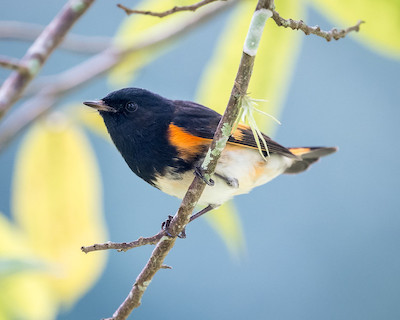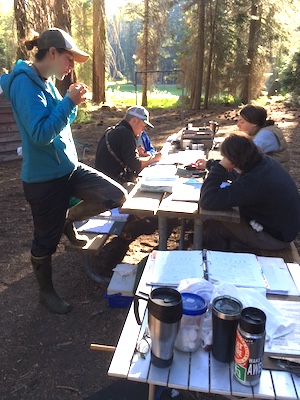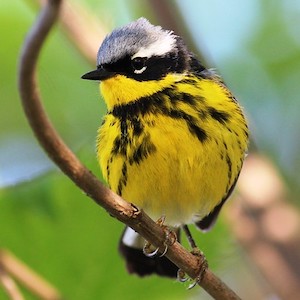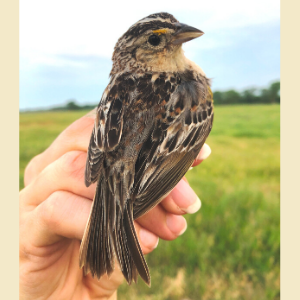As is implied by their name, sound is important to songbirds. These birds use vocalizations to attract mates, defend territories, keep tabs on their young and warn them when danger is near. It makes intuitive sense that noise would interfere with songbirds' ability to communicate and disturb them.
Unfortunately for birds, humans are noisy neighbors. We arrive with our car engines, fans, pumps, construction equipment and other noisy equipment and suddenly the neighborhood goes downhill. Studies have shown that in many local songbird populations anthropogenic, or human-caused, noise has negative impacts on bird abundance, health and reproduction. But does anthropogenic noise impact birds on a larger scale, for instance a species as a whole, rather than a single population?

Hermit Thrushes are less abundant in areas with more anthropogenic noise. Photo by Gary Yanchek/Flickr
A recent paper in the journal Avian Conservation and Ecology used MAPS banding data and ambient noise level estimates produced by the National Park Service to look at whether anthropogenic noise affects the abundance and productivity of 72 bird species across the United States. Many of the species studied showed changes in abundance or productivity (the number of young produced) in relation to noise, but those changes were not always in the direction you might think.
We talked to Dr. Darren Proppe of St. Edward's University, a co-author of the paper, and Amber Ng, lead author and Dr. Proppe's former undergraduate student who is now a master's degree student at Western Michigan University, about the conservation implications of this research and why they used the MAPS database.
What prompted you to look at the effect of noise on birds on a large spatial scale?
Dr. Proppe: Much of the research on noise that has been done to date has looked at impacts on particular populations. But, if you want to manage a species, like the red-breasted nuthatch for example, across its entire range, it is dangerous to scale up results from a single population to the species as a whole. This is because there are a number of localized factors that will impact populations differently from site to site.
This is not to suggest that large-scale datasets are better than localized studies. Rather, both have their place, and the best management practices will utilize information from studies at both scales. Our goal here was to help fill a gap in data at the larger scale. In the case of the red-breasted nuthatch, localized studies, and our continental USA results indicated that noise reduced abundance. Taken together, this implies that noise mitigation will be needed to maintain this species.
In your opinion, what is the most important finding of this study?
Dr. Proppe: Increasing noise levels impacted abundance and/or productivity in over ¼ of the species we examined. This indicates that the impacts of noise on bird communities are extensive enough to be detected at the continental scale – and therefore, that noise is an important issue of conservation concern if we aim to sustain songbird populations across their range. Finally, banding data clearly has much to contribute to our understanding of how noise impacts birds, and standardized programs like MAPS represent a valuable framework for examining this topic.
How do you think your findings might affect conservation decisions?
Dr. Proppe: Our data revealing how noise impacts 72 species across continental USA can be used by wildlife managers immediately to assess the impacts of noise on their species more broadly. Our results provide support for prioritizing noise mitigation in some species, and for focusing on other issues while data on noise continues to be collected for other species.
In addition, someone particularly interested in a species that we did not evaluate can use the method outlined in our study to calculate the effects of noise on any species captured regularly with mist nets in the continental USA. The R code, or the computer coding language needed to analyze the data, is provided.
Another wildlife management take home is this: Do not assume that changes in noise-associated abundance reflect noise-associated changes in productivity. We often allow ourselves to assume that abundance can be used as single-stop population demographic for assessing environmental impacts on species sustainability. The case where noise reduces both abundance and productivity, such as our results indicated for the American Redstart, is much more dire than the case where noise reduces abundance, but coincides with stable (or increased) productivity, such as we saw for the Chipping Sparrow.

Abundance and productivity of American Redstarts decline in areas with more anthropogenic noise. Photo by Becky Matsubara/Flickr.
Did any of your results surprise you?
Ms. Ng: We were a bit surprised that none of the life history traits that we looked at–such as song frequency, breeding habitat and diet–predicted the way a species was impacted by noise, since several other studies have found connections there.
Looking back at the species we chose to include in our study (because of high capture rates at banding stations or the availability of data), we might not have had enough variation in some of those traits to detect a relationship, even if there was one.
Can you explain in why productivity and abundance might be affected differently by noise? For instance in the Chipping Sparrow, more noise was related to lower abundance of these birds, but in noisy areas their productivity was stable.
Ms. Ng: Noisiness can cover up, or mask, other sounds, such as a bird's song to attract a mate, the sounds made by a predator, or the begging calls of offspring. Changes to each of these functions can then impact habitat choice, predation rates, or offspring survival in different ways, and we assess these effects by looking at changes in abundance and productivity.
If abundance is a measure of the degree to which a species is using a space, then productivity can be thought of as a measure of how well they are able to use that space for reproduction. Noise might cause some individuals in a species to generally avoid an area -- decreased abundance -- but individuals that do live there could still be able to produce a normal number of offspring -- stable productivity. Although resources, or a bird’s ability to detect resources, might be hampered by noise, fewer birds also means easier access to resources. Thus, reduced abundance might result in stable, or even increased productivity.
Why did you choose to work with the MAPS dataset in this study?
Dr. Proppe: The MAPS dataset offers two elements that are unique from other large-scale datasets. First, population demographics, such as abundance, are quantified without the assistance of aural surveys (e.g., counting birds using detection of their songs). Datasets using aural surveys are faced with a potential confound, in that ambient noise also reduces the likelihood of detecting singing birds.

MAPS banders at work in 2017. Photo by IBP.
Second, the MAPS dataset provides information on abundance, productivity, and survivorship. Most other large-scale datasets only collect abundance data. One of our objectives was to compare noise impacts on abundance and productivity. MAPS nicely facilitated that comparison. At some point we would like to investigate noise impacts on survivorship. That analysis would be quite a bit more complicated, but MAPS provides an avenue to explore the feasibility of this option.
Do you have plans to continue working with the MAPS program?
Ms. Ng: After completing this research I had the opportunity to assist with banding at a MAPS station, and I hope to do so again soon.
Dr. Proppe: I am working to develop a protocol that MAPS station managers can employ to easily record and report ambient noise at their stations. This study utilized modelled noise data produced by the US National Park Service. While the dataset has been widely validated, it provides only one measure of noise at each physical location. Using actual noise measurements taken from each station will allow us to incorporate annual changes in noise levels into future analysis.
Noise pollution, unfortunately, is not going away. Continued assessment of its impacts will be necessary, and we view the MAPS program as an excellent avenue for continued monitoring.






